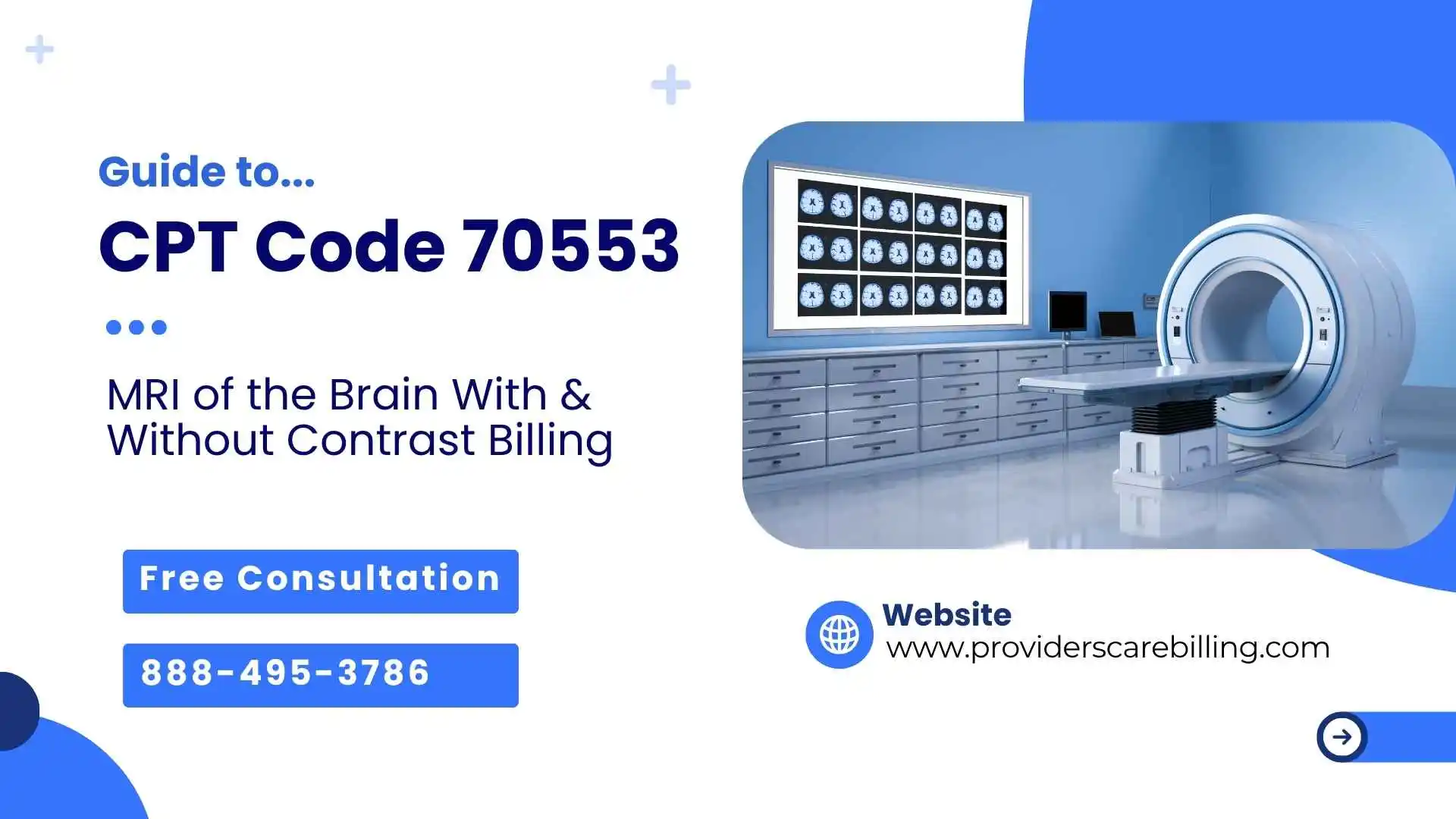Neurology is a highly specialized field, and the billing associated with the concerned procedures is also Complex. Magnetic Resonance Imaging (MRI) is a vital diagnostic technique that neurologists commonly use to identify a patient’s state. This guide will explain everything you should know about billing the CPT code 70553, i.e., a code related to MRI service. A deep understanding of this procedural code is necessary to make sure that the claims are submitted correctly and that they are reimbursed on time.
Did You Know?
Over 40 million MRIs are performed annually in the U.S., with brain and head imaging being among the most common. Yet, incorrect coding leads to millions in claim denials every year. Are you using CPT® 70553 correctly?
Any error in the billing process introduces delays and rejections of payment, which breaks the revenue cycle of the neurology practice. If you want a consistent source of income, follow this guide all the way through.
What Is CPT Code 70553?
The American Medical Association (AMA) has codified CPT code 70553 under the Diagnostic Radiology (Diagnostic Imaging) Procedures of the Head and Neck area. It describes the MRI study of the brain and brainstem when no contrast is available and when contrast material is provided.
CPT® 70553 refers to:
“Magnetic Resonance Imaging (MRI) of the brain (including brain stem) without contrast, followed by contrast(s) and further sequences.”
Key Differences from Related Codes
| CPT Code | Description |
| 70551 | MRI brain without contrast |
| 70552 | MRI brain with contrast |
| 70553 | MRI brain without & with contrast (most comprehensive) |
Note: For pituitary gland or internal auditory canal (IAC) imaging, 70553 is mandatory.
When Is CPT 70553 Used?
This code is used when:
- A non-contrast MRI is performed first.
- Contrast dye is then administered for enhanced imaging.
- Both scans are done in the same session
The following are some of the clinical conditions where the healthcare provider might require non-contrast MRI images coupled with the contrasted MRI image of the brain and brainstem:
1. Brain Tumors or Metastases
A patient who had a history of lung cancer complains of the new appearance of headaches and focal neurological impairments. The first examination of the neurologic signs is ataxia and nystagmus. Therefore, the neurologist orders an MRI of the brain and brainstem with and without contrast (CPT code 70553).
The non-contrast imaging scan helps the neurologist to rule out hemorrhage or edema. On the other hand, contrast images help highlight small metastases or primary brain tumors (e.g., gliomas, meningiomas) in the cerebellopontine angle or brainstem.
2. Unknown Seizures or Epilepsy Evaluation
A 30-year-old man is coming to the center of neurology. He is complaining of new development of generalized tonic-clonic seizures. The neurologist initiates a basic neurological test that is non-notable across the attacks. Thus, the neurologist will request a brain and brainstem MRI with contrast and without (CPT code 70553).
The non-contrast and contrast images assist the neurologist in exploring possible underlying structural anomalies like tumors or vascular malformations.
3. Cranial Nerve Disorders
A case report of a patient who experienced progressive facial numbness and diplopia indicates brainstem pathology. The doctor is concerned about the possibility of a lesion in the cranial nerves or brainstem. Thus, he exports an MRI with and without contrast (CPT 70553).
The non-contrast first images show any masses or structural changes. On the contrary, the contrasted images show the appearance of possible tumors, like meningiomas or neuromas, demyelinating lesions, or inflammation, such as sarcoidosis.
4. Pituitary Gland Abnormalities
A case of a patient presenting with a high level of prolactin and bitemporal hemianopia.
Pituitary microadenomas (<10mm) create a mandatory requirement for dynamic contrast imaging, and would be overlooked in non-contrast imaging.
5. Post-Stroke or Vascular Evaluation
A TIA patient who recurrently felt dizzy and had a negative CT angiography.
Non-contrast is used to assess acute hemorrhage, whereas contrast is used to detect cysticercosis or small infarcts and vasculitis, or venous sinus thrombosis.
Modifiers for CPT 70553
All the applicable modifiers to CPT 70553 have been discussed below:
Modifier TC
Do you want to bill the technical side of CPT code 70553 as a hospital or as an imaging facility? When yes, add the modifier TC. This is a signal to the payer that you are charging for equipment, supplies, and services of the non-physician professionals, but were not involved in the interpretation of the images.
Modifier 26
This modifier is used by health care providers to point out to the payer that they are only charging the professional component of CPT code 70553. This means that they interpreted the images and reported the report, but did not own the equipment.
Modifier 59
How do you address giving other procedures at the same time you conduct the brain MRI mentioned in the CPT code 70553? To show that the MRI is a special and substantial procedure, you use modifier 59 to make it a special procedure that will provide a separate reimbursement. It is a necessary amendment that will eliminate the cutting off the visits in payment because of unwarranted bundling of services.
Modifier 76
When the same physician repeats an MRI on the same day with and without contrast, add modifier 76 to CPT code 70553. It determines that the repetition was medically imperative and guides you out of the denial because of a duplication mistake.
Modifier 77
When the other physician repeats the non-contrast and the contrast imaging studies using CPT code 70553 during the same day, use modifier 77.
Don’t Leave Reimbursement to Chance!
Never end up denying a claim due to CPT 70553- leave the complexities to our expert medical billing services.
📞 Call Now: 888-495-3786
📧 Email: Info@providerscarebilling.com
➡️ Get a FREE billing audit today!
Billing & Reimbursement Guidelines
Billing and reimbursement guidelines of the CPT 70553 are as follows:
1. Medical Necessity Documentation
Documentation is very important to be reimbursed correctly. The medical record must make it clear:
- The symptoms of the patient indicate the MRI (e.g., frequent headaches, seizures, unexplained changes in vision, or focal neurological deficit).
- The previous scans (when available), including indeterminate CT scans or follow-up evidence of a known abnormal result.
- Contrast data, including contrast medication type (e.g., gadolinium) and the amount administered, versus indication of contrast administration (e.g., suspected tumor, infection, and inflammatory process).
Medicare & Private Payer Rules
- Medicare covers CPT 70553 but requires strict adherence to medical necessity guidelines. Acceptable indications include evaluating brain tumors, stroke, multiple sclerosis, or unexplained neurological deficits. Lack of proper justification may result in claim denials.
- Private insurers often impose additional requirements, such as prior authorization for contrast-enhanced MRIs. Some may request clinical notes or proof that a non-contrast MRI (70551) was insufficient before approving 70553.
Common Denial Reasons & How to Avoid Them
- Incorrect code bundling: There are instances of incorrect bundling of the codes where 70551 (non-contrast) and 70552 (with contrast) are billed individually rather than using the bundled 70553 code. This leads to automatic denials.
- Missing or incorrect modifiers: Lack of an appropriate modifier (26), professional component, or TC (technical component) can cause rejection.
- Insufficient documentation: Payers frequently deny claims if the medical record lacks clear evidence of why both non-contrast and contrast imaging were necessary. Always include detailed clinical reasoning.
Final Thoughts
Now that we have discussed this guide in detail, we will sum it up. But before we finish, what did we learn?
The first one was to describe the meaning of the CPT code 70553. It includes the non-contrast MRI and the subsequent contrasted imaging after the administration of the contrast material during the same session.
We also discussed some clinical examples when this CPT code can be used. These are progressive Cranial nerve deficits evaluation, new-onset seizures evaluation, and possible brain tumors or metastases. Then we talked about which modifiers can be applicable to CPT 70553 in various cases. These are TC 26, 59, 76, and 77.
Lastly, we researched the billing and reimbursement instructions. This is all you need to perfect the correct billing on CPT 70553. But unless you have an in-house certified professional coder (CPC), you might not get timely reimbursements. Thus, we suggest hiring a company to handle neurology billing activities, such as Providers Care Billing.
In many diagnostic workflows, especially when assessing neurological symptoms, physicians may also order cardiac testing like ECG to rule out cardiac-related causes. Learn more about how to code and bill for this service in our Complete Guide to ECG Billing with CPT Code 93000.
FAQs
Can I bill 70551 and 70552 together instead of 70553?
No. If both non-contrast and contrast MRIs are done in the same session, 70553 must be used.
What’s the CPT code for a pituitary MRI?
70553 is required for pituitary studies, as dynamic contrast imaging is essential for detecting microadenomas.




